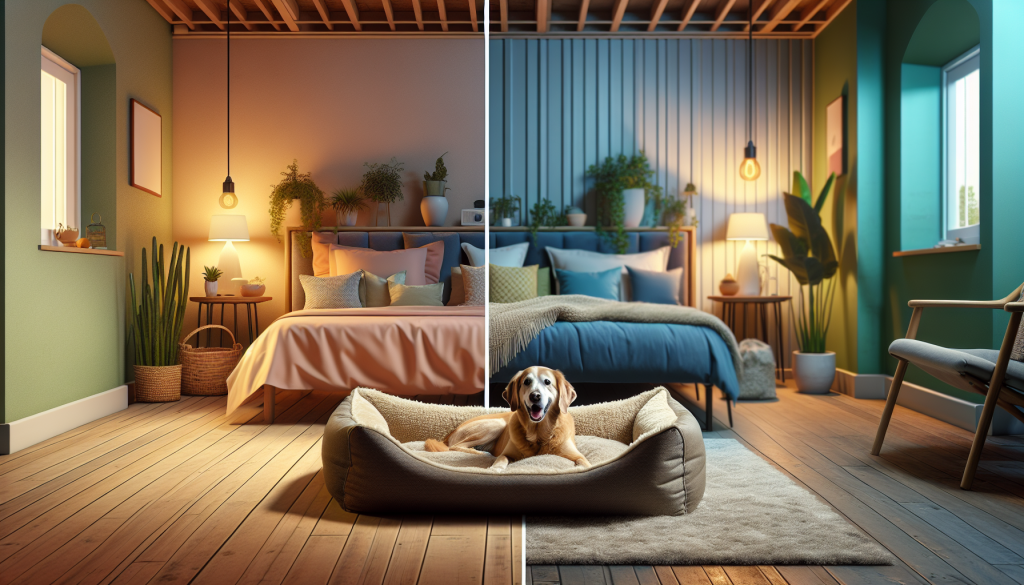Deciding whether to place your dog’s bed in the bedroom or living room can be a tough decision for pet owners. After all, you want your furry friend to feel comfortable and secure, but you also want to maintain a sense of order and cleanliness in your home. In this article, we will explore the pros and cons of both options, allowing you to make an informed choice that suits both you and your beloved dog.
Benefits of Having a Dog Bed
Comfort for Your Dog
Having a designated dog bed provides a comfortable space for your furry friend to relax and unwind. Dogs, just like humans, need a cozy spot to call their own. A dog bed provides the necessary cushioning and support for their joints and muscles, preventing discomfort and potential pain. By offering a dedicated space for your dog to rest, you can ensure that they always have a cozy and inviting place to nap or sleep.
Promotes Good Sleep
By providing your dog with a designated bed, you can help promote good sleep habits. Dogs, much like humans, require a calm and peaceful sleeping environment to ensure they get the proper rest they need. A dog bed can provide a sense of security and comfort, allowing your furry companion to enter into a deep and restful sleep. This not only benefits their overall health and well-being but also helps reduce the likelihood of them seeking alternative sleeping spots, such as your own bed or furniture.
Provides a Safe Space
A dog bed serves as a safe space where your furry friend can retreat to whenever they feel overwhelmed or need some alone time. Dogs, with their sensitive and vulnerable nature, can significantly benefit from a designated safe space. Whether it’s a place to seek refuge during thunderstorms or a spot to retreat to when they need a break from the hustle and bustle of the household, having a dog bed ensures that your dog always has a secure and comforting place to go.
Considerations for Choosing the Location
Size and Type of Bed
When choosing the location for your dog’s bed, it is essential to consider the size and type of bed you have for your furry friend. Larger beds may be better suited for living room spaces, where they can provide ample room for your dog to stretch out and relax. Smaller beds may be more suitable for bedrooms, where space may be limited. Additionally, consider the type of bed your dog prefers, such as a soft and plush bed or a raised cot-style bed, and ensure that the chosen location can accommodate it comfortably.
Dog’s Sleep Preferences
It is crucial to take into account your dog’s individual sleep preferences when deciding on the location of their bed. Some dogs may prefer a quiet and secluded sleeping area, while others may prefer to be in the middle of the action. Observe your dog’s behaviors and sleeping patterns to determine their preferences and choose a location that aligns with their needs. This will not only ensure their comfort but also contribute to their overall happiness and well-being.
Existing Furniture and Decor
Consider the existing furniture and decor in your home when deciding on the location of your dog’s bed. You want to choose a spot that integrates well with the overall aesthetic of your living space. Additionally, take into account any potential risks to furniture or decor when selecting the location. Some dogs may have a tendency to chew or scratch at furniture, so it is important to choose a location that minimizes the potential for damage.

Benefits of Having a Dog Bed in the Bedroom
Promotes Bonding and Emotional Support
Having a dog bed in the bedroom can promote a strong bond between you and your furry friend. Dogs are social creatures and often find comfort in being near their human companions. By allowing your dog to have their bed in the bedroom, you create a sense of closeness and promote emotional support. Your dog will appreciate being able to curl up near you while you sleep, enhancing your bond and providing them with a sense of security.
Easier Monitoring of Your Dog’s Health
Having your dog’s bed in the bedroom allows for easier monitoring of their health. Dogs are highly attuned to their owners and can often pick up on subtle cues and changes in behavior. By having your dog close to you during sleep, you can easily observe any unusual signs or symptoms, such as restlessness, excessive panting, or changes in breathing patterns. This can enable you to promptly address any health concerns and seek veterinary advice if needed.
Reduces Separation Anxiety
For dogs who experience separation anxiety, having their bed in the bedroom can offer comfort and alleviate stress. The presence of their human companion nearby can provide a soothing and calming effect, reducing feelings of isolation and anxiety. Being able to sleep near you can help your dog feel more secure and minimize the distress that often accompanies being separated from their owner. This can lead to improved overall well-being and a happier, more contented dog.
Benefits of Having a Dog Bed in the Living Room
Allows for Socialization and Familiarity
Placing your dog’s bed in the living room allows for increased socialization and familiarity with both family members and guests. Dogs are pack animals and enjoy being part of the family unit. By having their bed in the living room, your dog can be in the midst of everyday activities, providing them with opportunities for social interaction, reassurance, and companionship. This can promote a sense of belonging and ensure that your furry friend feels included and valued as an integral part of the household.
Ideal for Active and Alert Dogs
If you have an active and alert dog, having their bed in the living room can be highly beneficial. These dogs often enjoy being in the center of the action and having a clear view of their surroundings. Placing their bed in the living room allows them to keep an eye on everyone and everything, satisfying their natural curiosity and providing mental stimulation. Having their bed in a more dynamic environment can cater to their active nature and prevent boredom or restlessness.
Ease of Supervision
Placing your dog’s bed in the living room enables easy and constant supervision, which is particularly advantageous for puppies or dogs with specific training needs. Being in close proximity to your furry friend allows you to monitor their behavior, offer timely corrections, and reinforce positive behaviors. This level of supervision can aid in effective training, ensuring your dog develops good habits and becomes a well-behaved member of the household.

Potential Drawbacks of Having a Dog Bed in the Bedroom
Restricts Human Space and Movement
One potential drawback of having a dog bed in the bedroom is that it can limit human space and movement. Depending on the size of the bedroom and the dog bed, it may take up valuable floor space or obstruct pathways. This can make it difficult for you to navigate around the room or limit the usable space for other activities. Before deciding to have a dog bed in the bedroom, consider the impact it may have on your own comfort and convenience.
Potential for Disturbed Sleep
While having your dog’s bed in the bedroom can promote bonding, it may also result in disturbed sleep for some individuals. Dogs can be active during the night, causing disruptions and potentially waking you up. Additionally, some dogs may snore or move around frequently during sleep, leading to disturbances. If you are a light sleeper or value uninterrupted sleep, having a dog bed in the bedroom may not be the best option for you.
Allergies and Hygiene Concerns
If you or a family member have allergies, having a dog bed in the bedroom may exacerbate symptoms. Dogs can carry allergens such as dander, pollen, or dust mites, which can affect people with sensitivities. Additionally, maintaining cleanliness and hygiene becomes more crucial when a dog bed is in the bedroom, as it may accumulate dirt, hair, and odors more easily. Regular cleaning and washing of the bed are necessary to minimize potential allergy triggers and ensure a clean sleeping environment.
Potential Drawbacks of Having a Dog Bed in the Living Room
Limited Privacy and Quiet
Having a dog bed in the living room may limit your dog’s access to privacy and quiet time. The living room is often a bustling hub of activity, with family members and guests coming and going. This constant activity and noise can be overwhelming for some dogs, who may seek a more peaceful environment to rest or relax. If your dog prefers solitude or quiet, having their bed in the living room may not provide the level of tranquility they require.
Risk of Furniture Damage
Placing your dog’s bed in the living room holds the potential for furniture damage. Some dogs may be prone to chewing or scratching furniture, especially if they feel bored or anxious. With their bed in close proximity to furniture pieces, the temptation to engage in destructive behavior can be heightened. It is important to train your dog not to chew or scratch furniture and provide appropriate alternatives, such as chew toys or scratching posts, to divert their attention and prevent damage.
Potential for Accidents and Odors
Dogs, particularly puppies or older dogs with health issues, may have accidents indoors. Placing their bed in the living room increases the likelihood of accidents occurring in a more central and visible area of the house. It is important to properly house train your dog and take them outside regularly to minimize the risk of accidents. Additionally, accidents can lead to undesirable odors in the living room, which may require more frequent cleaning and maintenance.
Final Considerations
Dog’s Age and Health
When deciding on the location of your dog’s bed, consider their age and health. Puppies or senior dogs may have specific needs that influence the choice of location. Puppies may require closer supervision and easy access to the outdoors for potty training, making a living room bed more suitable. Senior dogs, on the other hand, may benefit from a bedroom bed to minimize mobility challenges during the night. Tailor the location to suit your dog’s individual needs and stage of life.
Personal Lifestyle and Schedule
Your personal lifestyle and schedule also play a significant role in determining the location of your dog’s bed. If you spend a lot of time in the living room and prefer to have your dog near you, having their bed in that space may be more convenient. However, if you prefer a quiet and undisturbed sleeping environment, having the dog bed in the bedroom may be a better option. Consider your daily routines and activities to choose a location that aligns with your lifestyle and preferences.
Alternative Options and Compromises
If you find it challenging to decide between the bedroom and living room, consider alternative options or compromises. You may choose to have multiple dog beds in different locations, allowing your dog to have options depending on their mood or your activities. Another option is to have the dog bed in a nearby hallway or dedicated dog space, providing a balance between proximity and privacy. Assess your specific circumstances and explore creative solutions to find the best arrangement for both you and your beloved furry companion.
In conclusion, there are numerous benefits to having a dog bed, regardless of the chosen location. Consider your dog’s comfort and sleep preferences, as well as your own lifestyle and needs, when deciding between the bedroom and living room. Balance the desire for bonding and emotional support with practical considerations and potential drawbacks. With careful thought and consideration, you can provide your dog with a comfortable and safe space that meets both their needs and yours.
